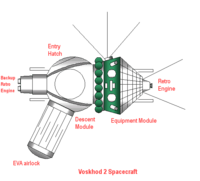Kosmos 110
Kosmos 110 |
| Mission type |
Biosciences |
|---|
| COSPAR ID |
1966-015A |
|---|
| SATCAT № |
2070 |
|---|
|
| Spacecraft properties |
|---|
| Spacecraft |
Vostok-3KV No.5 |
|---|
| Launch mass |
5,700 kilograms (12,600 lb) |
|---|
|
| Start of mission |
|---|
| Launch date |
22 February 1966, 20:09:36 (1966-02-22UTC20:09:36) UTC |
|---|
| Rocket |
Voskhod |
|---|
| Launch site |
Baikonur 31/6 |
|---|
|
| End of mission |
|---|
| Landing date |
16 March 1966 (1966-03-17) |
|---|
|
| Orbital parameters |
|---|
| Reference system |
Geocentric |
|---|
| Regime |
Low Earth |
|---|
Kosmos 110 (Russian: Космос 110 meaning Cosmos 110) was a Soviet spacecraft launched on 22 February 1966 from the Baikonur Cosmodrome aboard a Voskhod rocket.
Mission
It incorporated a re-entry body (capsule) for landing scientific instruments and test objects. It was a biological satellite that made a sustained biomedical experiment through the Van Allen radiation belts with the dogs Veterok and Ugolyok, after 22 days in orbit around the Earth, they were safely landed.[1]
This spaceflight of record-breaking duration was not surpassed by humans until Soyuz 11 in June 1971 and still stands as the longest space flight by dogs.
Details
Other Names
See also
References
|
|---|
| | Bion precursor flight | |
|---|
| | Bion flights | |
|---|
| | Bion-M | |
|---|
| (Kosmos number in brackets) |
|
|
|---|
| | | Payloads are separated by bullets ( · ), launches by pipes ( | ). Manned flights are indicated in bold text. Uncatalogued launch failures are listed in italics. Payloads deployed from other spacecraft are denoted in brackets. |
|

